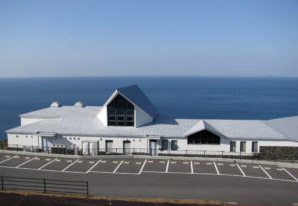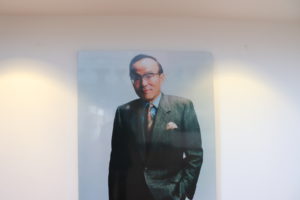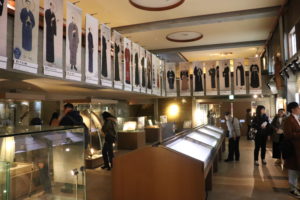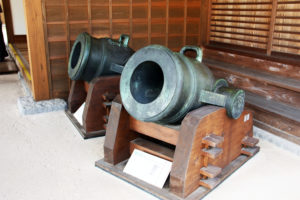Endo Shusaku Literary Museum, in Sotome, Nagasaki
The peaceful Sotome, the setting of Endo Shusaku’s novel Silence. Sotome area of Nagasaki
city has an abundance of natural beauty in its sea, mountains and rivers. It also is blessed with
a unique history and culture of Christianity. In particular, the area in which the Endo Shusaku
Literary Museum stands is known as the site of a Christian village, one of Endo’s most notable
work, Silence.
From the literary museum, there is a magnificent view. In a sweep of eye one can see sun as
it majestically sets over the sea of Goto, along with the Silence Literary Monument in Shitsu
Bunka Mura. Endo Shusaku and the Sotome area are linked through Silence ; this bond has
been built up starting from when Endo was writing the novel, and continues into the present day
with the construction of literary museum.
 |
 |
 |
Following Endo Shusaku’s death, this Literary Museum was established thanks to kindness of
his family, and was filled with Endo’s persona belongings, mementoes, manuscripts, and his
extensive collection of books. The Museum exhibits trace the footsteps of Endo Shusaku as
one of Japan’s greatest writers of literature. In addition, it has facilities for collecting, preserving,
and exhibiting materials related to Endo’s public perusal and research, and operating as an
information center.
Note : Silence
Silence is a 1966 novel of theological fiction by author Endo Shusaku, published in English by
Peter Owen Publishers. It is the story of a Jesuit missionary sent to 17th century Japan, who
endures persecution in the time of Hidden Christians that followed the defeat of the Shimabara
Rebellion. The recipient of the 1966 Tanizaki Prize, it has been called “Endo’s supreme
achievement and “one of the twentieth century’s finest novels Written partly in the form of a letter
by its central character, the theme of a silent God who accompanies a believer in adversity was
greatly influenced by the Catholic Endō’s experience of religious discrimination in Japan, racism
in France, and a debilitating bout with tuberculosis.
The 26 Martyrs Museum, in Nagasaki
The 26 Martyrs Museum is dedicated to the 26 Christians who were executed here on
February 5, 1597. They included both foreign missionaries and Japanese laymen. Missionary
activities were prohibited at the time, and Japan’s ruler Toyotomi Hideyoshi staged the execution
as a warning. The monument is located in a small park on a hill not far from Nagasaki Station
and offers nice views over the city.
 |
 |
 |
A straight red line runs from the Monument across the park’s plaza in the direction of the Oura
Cathedral on the opposite side of the city. Oura Cathedral is also dedicated to the 26 martyrs.
The museum behind the monument is devoted to the memory of the martyrs and to Christianity in
Japan in general. Its interior is reminiscent of a church with stained-glass windows, making for
atmospheric viewing of the exhibits. On display are artifacts related to Christianity in Japan,
including old documents, statues and jewelry.
Amakusa Shiro Memorial Hall, in Amakusa
The museum is a Christian Pilgrimage site shows History of Christianity in Amakusa
and Shimabara Rebellion which was a peasant uprising agaist bakufu’s persecution
of Christians under the leadership of Amakusa Shiro in 1637.
 |
 |
 |
Environmental Museum, in Kitakyushu
The museum has Environmental learning function, Environmental information
function and Environmental activity function. The Environmental improvement
history of Kitakyushu, Global warming and other various environmental issues
can be learned.
|
|
|
|
Hakata Machiya Furusatokan, in Fukuoka-city
The folk museum depicts the life and culture of Hakata Fukuoka. It is located near
the Kushida Shrine, Tochoji temple and Canal City Hakata.
 |
 |
 |
Exhibition hall, you can find the many faces and facets of the Hakata way of life,
Machiya hall, is a superb example of traditional architecture and has been moved
here and restored to provide a glimpse into the past.
Chiran Peace Museum for the Kamikaze Pilots, in Chiran
This museum exhibits precious materials such as pictures, letters, wills, articles and
mementos of the 1,036 Kamikaze pilots based in Chiran who participated in the Battle for
Okinawa towards the end of World War 2. It also houses a No.3 type fighter aircraft, Hien.
|
|
|
|
Tachiarai Peace Memorial Museum, in Asakura
The main exhibit room displays a few letters and other items of kamikaze pilots who died
in battle. One case has photos of about 50 kamikaze pilots from Tachiarai Air Base and
includes the following information on each pilot: name, unit, plane used, date of death,
and air base of final sortie.
 |
 |
 |
The museum does not give any historical summary of the kamikaze operations but rather
focuses on the stories of the pilots stationed at Tachiarai Air Base.
Saga Castle History Museum, in Saga
Japan’s Industrial Modernization activity was started here.
The largest restored wooden building in Japan at 2,500m2, the museum offers
the unparalleled chance to experience a Japanese castle from more than
175 years ago.
 |
 |
 |
Former Pattern Shop / Shipyard History Museum, in Nagasaki
The Former Pattern Shop has been registered on UNESCO World Heritage
as Sites of Japan’s Meiji Industrial Revolution. The Former Pattern Shop was built in
1898 to produce wooden patterns for castings and is the oldest factory building in the
shipyard. It is a two-storied brick building with a timber roof truss. There is a U-shaped
rail on the ceiling to transport materials. The building was refurbished to the Shipyard
History Museum in 1985 and is open to the public.
 |
 |
 |
Atomic Bomb Museum, in Nagasaki
Atomic Bomb Museum opened in Nagasaki Peace Park in 1996 as part of the 50th
anniversary project for the Nagasaki atomic bombing.
The museum replaced Nagasaki International Cultural Hall, where a number of
artifacts related to the atomic bombing were exhibited.
 |
 |
 |
In addition to these artifacts, the museum exhibits a number of photograph that
depict the devastation caused by atomic bomb showing the lead-up to this tragic
day, the history of the development of nuclear arms and our desire for peace.






